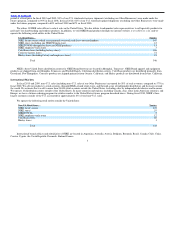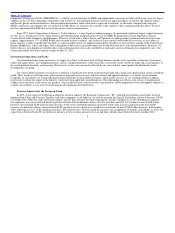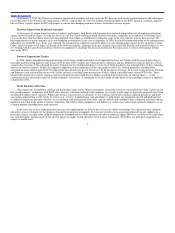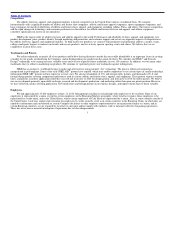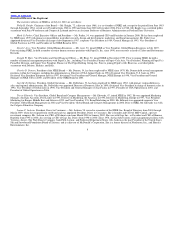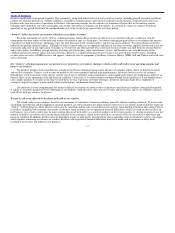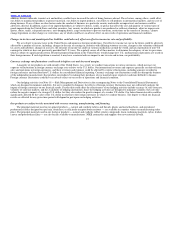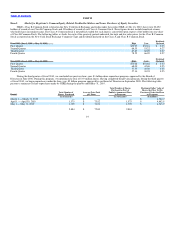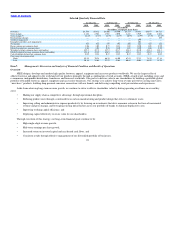Nike 2010 Annual Report Download - page 16
Download and view the complete annual report
Please find page 16 of the 2010 Nike annual report below. You can navigate through the pages in the report by either clicking on the pages listed below, or by using the keyword search tool below to find specific information within the annual report.
Table of Contents
fluctuate significantly from period to period. This seasonality, along with other factors that are beyond our control, including general economic conditions,
changes in consumer preferences, weather conditions, availability of import quotas and currency exchange rate fluctuations, could adversely affect our
business and cause our results of operations to fluctuate. Our operating margins are also sensitive to a number of factors that are beyond our control,
including shifts in product sales mix, geographic sales trends, and currency exchange rate fluctuations, all of which we expect to continue. Results of
operations in any period should not be considered indicative of the results to be expected for any future period.
“Futures” orders may not be an accurate indication of our future revenues.
We make substantial use of our “futures” ordering program, which allows retailers to order five to six months in advance of delivery with the
commitment that their orders will be delivered within a set period of time at a fixed price. Our futures ordering program allows us to minimize the amount
of products we hold in inventory, purchasing costs, the time necessary to fill customer orders, and the risk of non−delivery. We report changes in futures
orders in our periodic financial reports. Although we believe futures orders are an important indicator of our future revenues, reported futures orders are not
necessarily indicative of our expectation of changes in revenues for any future period. This is because the mix of orders can shift between advance/futures
and at−once orders. In addition, foreign currency exchange rate fluctuations, order cancellations, returns, and discounts can cause differences in the
comparisons between futures orders and actual revenues. Moreover, a significant portion of our revenue is not derived from futures orders, including
at−once close−out sales of NIKE footwear and apparel, wholesale sales of equipment, Cole Haan, Converse, Hurley, NIKE Golf and Umbro, and retail sales
across all brands.
Our “futures” ordering program does not prevent excess inventories or inventory shortages, which could result in decreased operating margins and
harm to our business.
We purchase products from manufacturers outside of our futures ordering program and in advance of customer orders, which we hold in inventory
and resell to customers. There is a risk we may be unable to sell excess products ordered from manufacturers. Inventory levels in excess of customer
demand may result in inventory write−downs, and the sale of excess inventory at discounted prices could significantly impair our brand image and have an
adverse effect on our operating results and financial condition. Conversely, if we underestimate consumer demand for our products or if our manufacturers
fail to supply products we require at the time we need them, we may experience inventory shortages. Inventory shortages might delay shipments to
customers, negatively impact retailer and distributor relationships, and diminish brand loyalty.
The difficulty in forecasting demand also makes it difficult to estimate our future results of operations and financial condition from period to period.
A failure to accurately predict the level of demand for our products could adversely affect our net revenues and net income, and we are unlikely to forecast
such effects with any certainty in advance.
We may be adversely affected by the financial health of our retailers.
We extend credit to our customers based on an assessment of a customer’s financial condition, generally without requiring collateral. To assist in the
scheduling of production and the shipping of seasonal products, we offer customers the ability to place orders five to six months ahead of delivery under our
“futures” ordering program. These advance orders may be cancelled, and the risk of cancellation may increase when dealing with financially ailing retailers
or retailers struggling with economic uncertainty. In the past, some customers have experienced financial difficulties, which have had an adverse effect on
our business. As a result, retailers may be more cautious than usual with orders as a result of weakness in the retail economy. A slowing economy in our key
markets could have an adverse effect on the financial health of our customers, which in turn could have an adverse effect on our results of operations and
financial condition. In addition, product sales are dependent in part on high quality merchandising and an appealing store environment to attract consumers,
which requires continuing investments by retailers. Retailers who experience financial difficulties may fail to make such investments or delay them,
resulting in lower sales and orders for our products.
13


